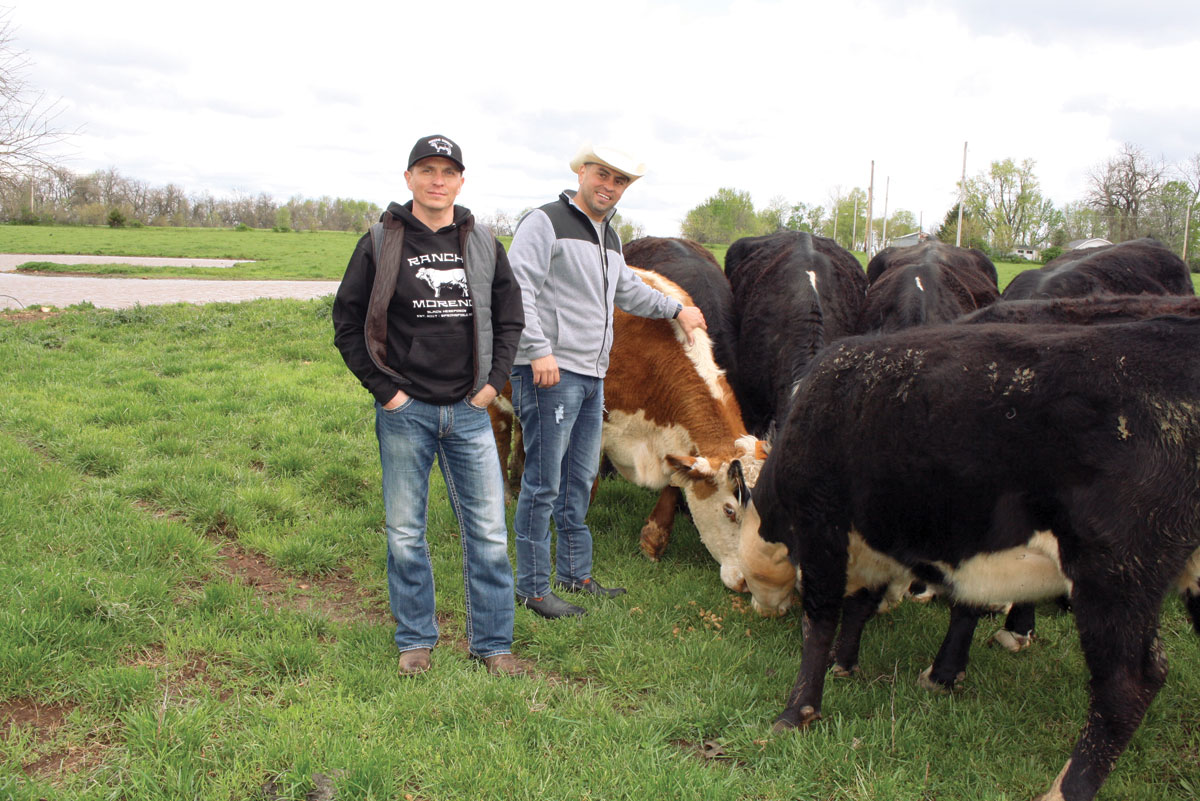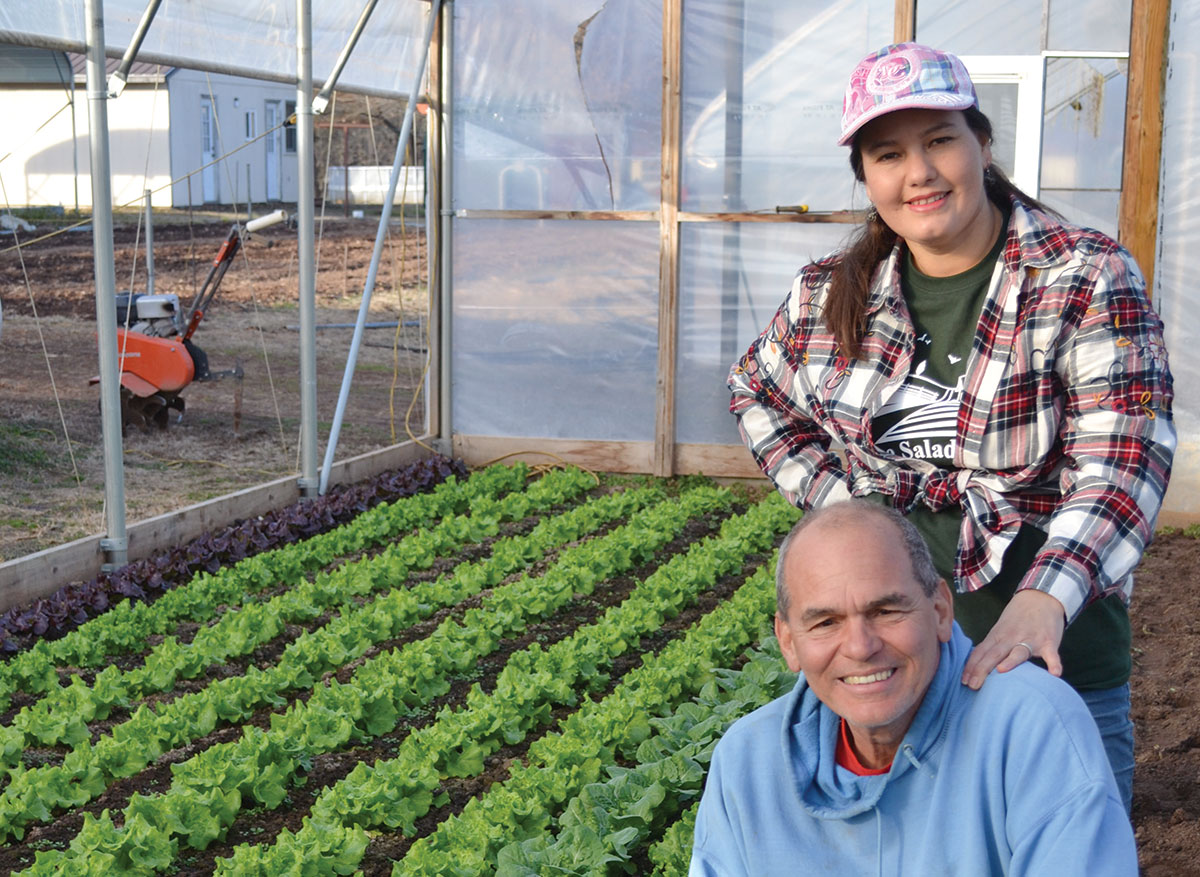
Caleb and Jacob Moreno appreciate the docile temperament of their Black Hereford cattle. Any signs of aggression is a culling factor for Rancho Moreno.
Brothers Caleb and Jacob Moreno seek top-quality genetics for their Black Hereford operation
The cattle business began as a sideline for Caleb Moreno as he acquired property, but the passion he and his brother Jacob have for breeding the highest-quality Black Hereford possible is a top priority.
The Morenos are partners in Rancho Moreno, which has more than 100 head of registered cattle on three farms.
The brothers grew up in Hereford, Texas, and their father’s transfer with the Assemblies of God Church brought them to Springfield, Mo.
“We didn’t have cattle, but all of our friends had cattle,” Caleb said. “We were preacher’s kids, so we didn’t have time for cattle, but we were around cattle. When I got into commercial real estate and acquired more and more land, we got into cattle.”
They began with a herd of Hereford cattle, but about four years ago they began to transition into Black Herefords.
“We knew the black-hided cattle brought more money, but we wanted the heterosis on the Hereford side,” Caleb explained.
“It was something new,” Jacob added. “All of your neighbors have black Angus, but no one had Black Herefords.”
Sold on the Black Hereford breed, the brothers found it difficult in the early days of their operation to find the genetics they sought locally.
“We had to go to Utah, Kansas and Nebraska because there weren’t any here, and when we did find them, we had to pay prime prices,” Caleb said.
The foundation of the Rancho Moreno herd can be traced back to some of the foundation Black Hereford animals, and the farm is now straight Black Herford, except for eight registered Herefords cows from the Domino line, which are genetics the brothers wish to retain in their herd.
Optimal performance is the goal of Rancho Moreno, so the brothers strive to have the best genetics possible, which includes genetics that will allow cattle to thrive on fescue and native grasses.
“We have herd bulls that are producing calves that are weaning at more than 600 pounds at 6 months of age,” Caleb said. “It’s hard to get cows to wean in that range with the very little feed they get. They are doing well, and commercial producers see that. About 10 percent of our cattle’s diet is from feed, but we want our cattle to be raised on grass.”
“If you keep numbers on your EPDs, the first six months are crucial,” Jacob added. “We like to keep our cattle as honest as possible, so there’s no creep feeding or anything like that. We want to see how cows do on grass. It’s all about performance, and that’s what we try to do. We want to see what our cattle can do, so we keep the grain at a minimum.”
A variety of mineral supplements are offered to cattle, and pastures are stockpiled, when possible, to keep forages available year round, and hay is produced on the farm.
“We have some pastures we don’t have to do anything with, while others we try to overseed and fertilize, others have great stands of brome,” Jacob explained. “We like to keep our bulls on heavy brome pasture. We pride ourselves on bulls that can perform and hold condition.”
The breeding program at Rancho Moreno is a combination of AI and natural cover, with the majority of heifers bred via AI.
“We don’t like pulling calves on heifers,” Caleb said. “We AI for that reason and try to keep birth weights under 70 pounds, but on these older mommas, it’s not unusual to have 90- to 100-pound calves with no issues.”
Approximately, 75 percent of the heifer crop, at this time, is retained annually.
Because optimal performance is expected, heifers are typically not bred until they are 16 to 18 months of age.
“Breeding heifers at 13, 14 months doesn’t allow the full potential of their genetics to come out,” Caleb said. “Our emphasis on our farm is to get the best genetics we can, keep the best records we can to further the American Black Hereford Association, so it’s important to let them grow so the people purchasing cattle get the best cattle they can.”
Bulls are also allowed to mature before being marketed.
“About 95 percent are 2 years old before they leave our farm,” Caleb said. “We want to see how they perform before we sell them. We have a bull this year that we wanted to use on some of our cattle, so we’re retaining the rights on him for a while. We reserve semen rights for some of our bulls.”
Bulls from Rancho Moreno can be found as far away as Texas and Arkansans, and semen is also offered for sale.
Thanks to the marketing of the American Black Hereford Association and the growing popularity of the breed, Caleb said their operation is seeing growth each year.
“We’re all trying to better the Black Hereford breed and breeders don’t look at others as competition; we’re all doing the best we can with Black Herefords,” he said.
Because genetics are the priority, few calves are born into the Moreno herd that are not seedstock prospects.
“With our genetics the way they are, it allows us to stay on top of that curve,“ Jacob said. “Because there are so few herds out there, we can pinpoint where we want to take our herd genetically. Any culls we need to do on mommas is done. If we don’t like something in the DNA or if they are horned, they are culled.”
The Moreno brothers are firm believers in the Black Hereford breed and stump for the benefits of the breed in a commercial herd.
“A Black Hereford bull will add 30 percent to your weaning weights; that brings dollars to your pocket,” Jacob said. “You’re bringing the heterosis and the black hide, so you’re getting the best of both worlds. Most farmers like the homozygous black bulls, so if we’re able to bring that black hide into that commercial herd and adding an average of 30 percent on weaning weights, that’s more dollars to you.”
“You have the best of both worlds with the carcass and marbling with the Angus and Hereford,” Caleb added. “Used to you had to go to the Angus for the carcass and the Hereford for marbling, we’re getting both in one breed.”
The Morenos have begun monitoring their carcass traits to add yet another level of performance to their herd.
As they continue to develop their genetics, the Morenos have a specific goal in mind.
“We want to have the best Black Hereford genetics in the United States,” Caleb said. “We haven’t gone out and bought the cheapest females because we want the best genetics possible for our operation and the breed. We’re not trying to run 300 head; we want the best genetics and seedstock we can so we can share that with our clients.”






